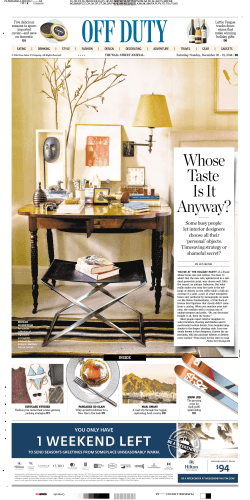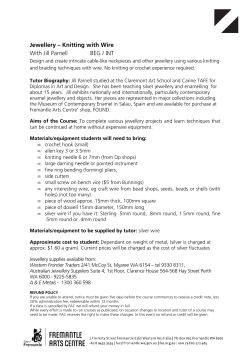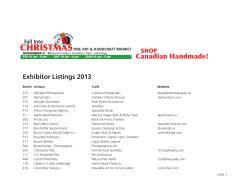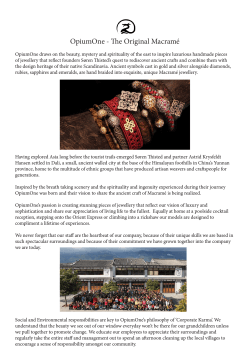
Exhibition programme 2015 How We Work Dutch Design
Exhibition programme 2015 Stedelijk Museum ’s-Hertogenbosch museum of contemporary art and design How We Work new Dutch Design 24 January – 17 May 2015 Food for Thought Eat, drink, design 30 May – 30 August 2015 Erik Andriesse “I wish I had known you” The unknown ceramics and drawings 30 May – 30 August 2015 FRAMED by Anne Wenzel Art, politics and history 12 September 2015 – 3 January 2016 Daniel Kruger Jewellery and Ceramics 1974 - 2014 17 October 2015 – 24 January 2016 How We Work new Dutch Design Saturday 24 January – Sunday 17 May 2015 After the international success of Dutch Design, a younger generation of designers from the Netherlands is taking new directions. This committed generation inquires after the role and function of design. The central question: What are we to do with the surplus of things, objects and design knickknacks? Renewal arises from taking account. These designers look around them and ask themselves: How can things be done differently? The inquiring working process of these young designers leads to new insights, processes and solutions. The merits of craft and traditional skills are reassessed, while meticulous research on materials and colour may or may not combine with the latest production techniques and innovations. High quality and sustainability are the answer to mass production and overproduction. Guest curator Tatjana Quax (studio Aandacht) and the museum selected one object by each of fourteen designers to show the process and story of how and why it was made. Fourteen very diverse products will be presented to offer insight into how designers work and think. With: Atelier NL, Pieke Bergmans, Mae Engelgeer, Formafantasma, Pepe Heykoop, Chris Kabel, Maarten Kolk & Guus Kusters, Dirk van der Kooij, Joris Laarman, Valentin Loellmann, Christien Meindertsma, Lex Pott, rENs and Scholten & Baijings. Summer 2015: Food for Thought Eat, drink, design Saturday 30 May – Sunday 30 August 2015 Today's designers see food as offering more of a challenge than just designing beautiful and practical products. Sustainability in design and use is an important principle for young designers. The social issues that revolve around the food supply often play an important part in the design process, the production and the product. Design is here deployed to develop new concepts and models while giving priority to sustainability. An example is the project Autarchy by Studio Formafantasma, in which the designers carry out research on a self-sufficient food production on the basis of a (locally available) raw material. The preparation and consumption of food is also attracting a lot of attention from consumers and lifestyle magazines. Cooking has become a hobby on which a great deal of time and money are spent. The products used in the making must reflect this. Because of the ecological issues and food scandals, Western consumers are greatly concerned about quality and where their food comes from: local, small-scale and biological. The thematic presentation Food for thought will present these developments in an interactive way in an exhibition of the work and ideas of artists and designers from the Netherlands and further afield. Erik Andriesse “I wish I had known you” The unknown ceramics and drawings 30 May – 30 August 2015 Erik Andriesse (1957-1993) is well known for his expressive paintings and drawings of flowers, skulls and animal skeletons. Some of the inspiration for his explosive style of drawing and painting came from the spontaneity of graffiti and the German Junge Wilde movement of the 1980s. It is less well known that, at the invitation of the Stedelijk Museum 's-Hertogenbosch, Erik Andriesse made ceramics in the European Ceramic Work Centre during what was to be the last year of his short life. These bowls and vases, often large in size, are closely related to his drawings and paintings in terms of theme and use of colour. Most of them have never been shown before and are still in the hands of the foundation in charge of his legacy. This will be the first exhibition to present an almost complete survey of the ceramic work of Erik Andriesse. Autumn 2015: FRAMED by Anne Wenzel Art, politics and history 12 September 2015 – 3 January 2016 FRAMED is a series of exhibitions in which an artist who is represented in the collection of the Stedelijk Museum ’s-Hertogenbosch is invited to act as guest curator. The idea is to confront a selection of their oeuvre with works of art or artists with which they feel an affinity or that challenge them and raise questions. In their relation to one another, the works of art chosen form a network of personal sources of inspiration and thematic links, thereby bringing out the artist's fascinations. The next artist/guest curator after Ted Noten in the series FRAMED is the German-born artist Anne Wenzel (1972, Schüttorf). Her sculptures and installations link historical tradition with the present. Her work is represented in the Stedelijk Museum ’s-Hertogenbosch with the ceramic sculpture Bright Solitude (Chandelier) from 2007. This sculpture is an artistic statement: an enormous blackened chandelier alludes to the historical richness of Baroque while at the same time indirectly referring to a hurricane disaster from the recent history of America. The representation of violence and decay, and how they can be expressed in beauty, is a recurrent theme in her oeuvre. The selection of contemporary and older works by Anne Wenzel will focus on art as a reflection of (art) history and on art in relation to contemporary politics and society. An essential aspect here is to raise questions and recalibrate existing patterns of thought. Boundaries will be sought and crossed in the process, such as that between autonomous sculpture, installation and cinematographic/narrative. Anne Wenzel will present it all in a total installation. Daniel Kruger Jewellery and Ceramics 1974 - 2014 17 October 2015 – 24 January 2016 The South African artist Daniel Kruger (1951) is best known as a jewellery designer and teacher. He has been living and working in Germany since 1974. Between 1988 and 2005 he did ceramic work as well as jewellery: vases, bowls and utilities. The Stedelijk Museum ’s-Hertogenbosch has been collecting and exhibiting the ceramics and jewellery of Daniel Kruger ever since the early 1980s. Daniel Kruger's jewellery has a strongly personal signature: he often uses (South African) precious stones and gold, but is just as much at home with base metals and pigments. His work refers to craftsmanship, ethnographic objects and historic jewellery. He constantly strives to strike a balance between high and low, geometric and organic forms, order and chaos, art and nature. This retrospective has already been presented in the Grassi Museum Leipzig, Schmuckmuseum Pforzheim, and the Deutsches Goldschmiedehaus Hanau. To accompany the exhibition the catalogue Daniel Kruger, Between Nature and Artifice, Jewellery 1974 – 2014 has been published.
© Copyright 2025











